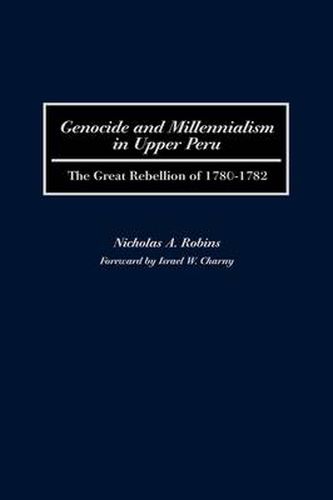Readings Newsletter
Become a Readings Member to make your shopping experience even easier.
Sign in or sign up for free!
You’re not far away from qualifying for FREE standard shipping within Australia
You’ve qualified for FREE standard shipping within Australia
The cart is loading…






Spaniards were the target of the chiliastic turned genocidal Indian-led Great Rebellion of 1780-1782 in South America. Exploring one of the least studied genocides in post-conquest South America, Robins calls into question many of the central assumptions currently held by genocide scholars. Victims of genocide usually lack the organization and weaponry to battle their enemies. During the 1780-1782 Great Rebellion in Peru and Upper Peru (now Bolivia), however, the Indian revolutionaries faced the better-organized and armed loyalist army. Whereas genocidal policies are usually characterized by centralized leadership, the Great Rebellion was highly fragmented and confederational in nature, undercutting the widely-held assumption that only the State is capable of committing genocide. The Rebellion is one of the rare cases when the victims of genocide emerged victorious. Focusing on the events occurring in the region south of La Paz, Robins examines how a native millennial movement evolved into an Indian-led attempt at genocide, dealing an unprecedented challenge to Spanish rule in the Americas. In the eyes of the rebels, this revolt fulfilled prophecies of an inevitable, divinely assisted, and long-awaited return of native rule. Just like at the dawn of the colonial period, this new era was to be born of pachacuti, or cataclysm. But this time the Spanish interlopers and their culture would be targeted for destruction.
$9.00 standard shipping within Australia
FREE standard shipping within Australia for orders over $100.00
Express & International shipping calculated at checkout
Spaniards were the target of the chiliastic turned genocidal Indian-led Great Rebellion of 1780-1782 in South America. Exploring one of the least studied genocides in post-conquest South America, Robins calls into question many of the central assumptions currently held by genocide scholars. Victims of genocide usually lack the organization and weaponry to battle their enemies. During the 1780-1782 Great Rebellion in Peru and Upper Peru (now Bolivia), however, the Indian revolutionaries faced the better-organized and armed loyalist army. Whereas genocidal policies are usually characterized by centralized leadership, the Great Rebellion was highly fragmented and confederational in nature, undercutting the widely-held assumption that only the State is capable of committing genocide. The Rebellion is one of the rare cases when the victims of genocide emerged victorious. Focusing on the events occurring in the region south of La Paz, Robins examines how a native millennial movement evolved into an Indian-led attempt at genocide, dealing an unprecedented challenge to Spanish rule in the Americas. In the eyes of the rebels, this revolt fulfilled prophecies of an inevitable, divinely assisted, and long-awaited return of native rule. Just like at the dawn of the colonial period, this new era was to be born of pachacuti, or cataclysm. But this time the Spanish interlopers and their culture would be targeted for destruction.